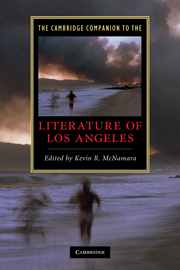Book contents
- Frontmatter
- Introduction: landmarks
- 1 The literature of the Californios
- 2 The Anglo invention of Los Angeles
- 3 LA fiction through mid-century
- 4 British expatriates and German exiles in 1930s-1940s Los Angeles
- 5 Postwar Los Angeles: suburban Eden and the fall into history
- 6 Los Angeles and the African-American literary imagination
- 7 Pacific Rim city: Asian-American and Latino literature
- 8 The literature of urban rebellion
- 9 City of sleuths
- 10 Los Angeles’ science fiction futures
- 11 Hollywood fictions
- 12 The Southland on screen
- 13 Scenes and movements in Southern California poetry
- 14 Surf, sagebrush, and cement rivers: Reimagining nature in Los Angeles
- 15 Essaying Los Angeles
- Guide to further reading
- Index
Introduction: landmarks
Published online by Cambridge University Press: 28 May 2010
- Frontmatter
- Introduction: landmarks
- 1 The literature of the Californios
- 2 The Anglo invention of Los Angeles
- 3 LA fiction through mid-century
- 4 British expatriates and German exiles in 1930s-1940s Los Angeles
- 5 Postwar Los Angeles: suburban Eden and the fall into history
- 6 Los Angeles and the African-American literary imagination
- 7 Pacific Rim city: Asian-American and Latino literature
- 8 The literature of urban rebellion
- 9 City of sleuths
- 10 Los Angeles’ science fiction futures
- 11 Hollywood fictions
- 12 The Southland on screen
- 13 Scenes and movements in Southern California poetry
- 14 Surf, sagebrush, and cement rivers: Reimagining nature in Los Angeles
- 15 Essaying Los Angeles
- Guide to further reading
- Index
Summary
“A good deal about California does not, on its own preferred terms, add up.” Joan Didion, Where I Was From (2003) / Defining the geographic extent of Los Angeles is the first challenge for anyone who would study its literature. Concentration defines New York, where even Brooklynites refer to Manhattan as “the city.” Los Angeles is defined by sprawl. Much of iconic Los Angeles, from the beaches of Baywatch to the streets of Beverly Hills, 90210, lies beyond the city limits. The larger Los Angeles County still fails to encompass Disneyland, Fontana (Mike Davis's “Junkyard of Dreams”), and Huntington Beach, whose pier is “one of the constituent monuments of the surfing life.” As a literary subject, however, Los Angeles is less a city, county, or “metropolitan statistical area” than a state of being (of grace, fear, emergency, or exception, depending on whom one reads) anchored in the area south of the Tehachapi Mountains, north of San Diego, west of the desert, and squarely in the collective imagination of utopia, dystopia, and, more recently, the urban future. A tour of some of mythic Los Angeles' landmark features will introduce our subject. More than any other American city, Los Angeles is a city made of words. It “did not so much grow as sell itself into existence,” William Alexander McClung observes. This marketing effort was not limited to the Chamber of Commerce and developers. The visual and verbal artistry of painters, photographers, and writers like the coterie around Charles Fletcher Lummis at the magazine Land of Sunshine, and even the logos on crates of produce shipped back east, helped to transform climate into a “palpable . . . commodity that [could] be labeled, priced, and marketed.”
- Type
- Chapter
- Information
- Publisher: Cambridge University PressPrint publication year: 2010

